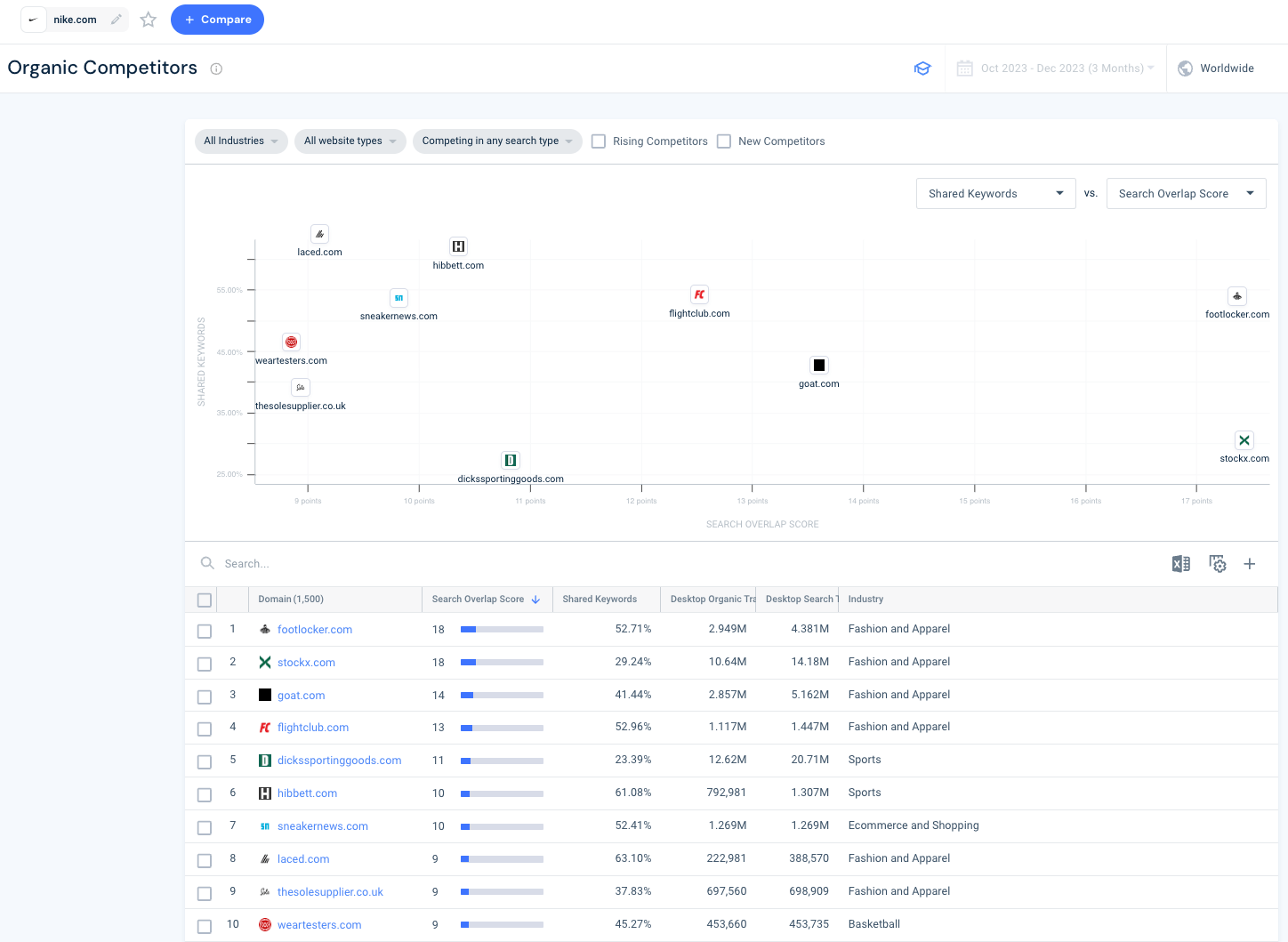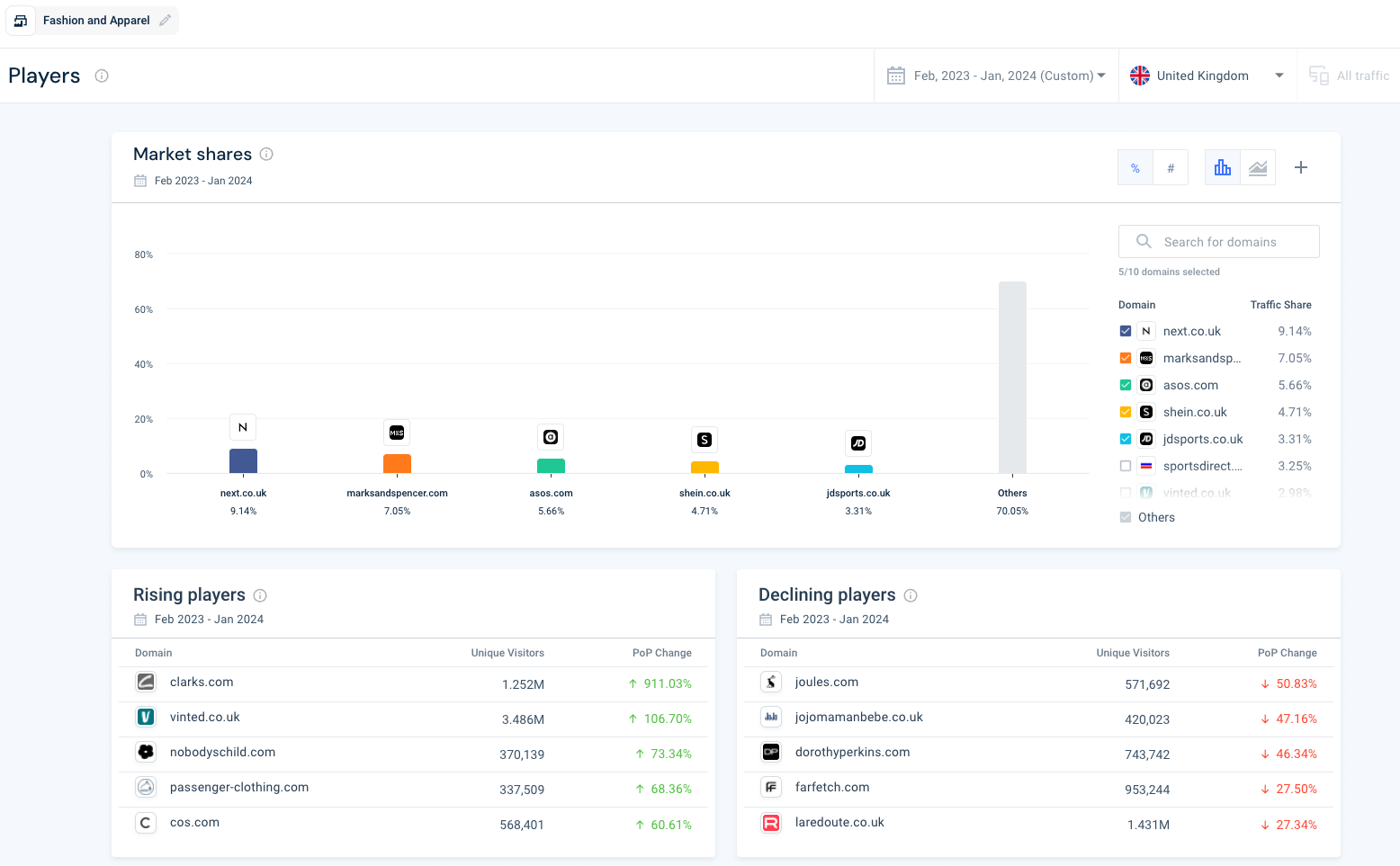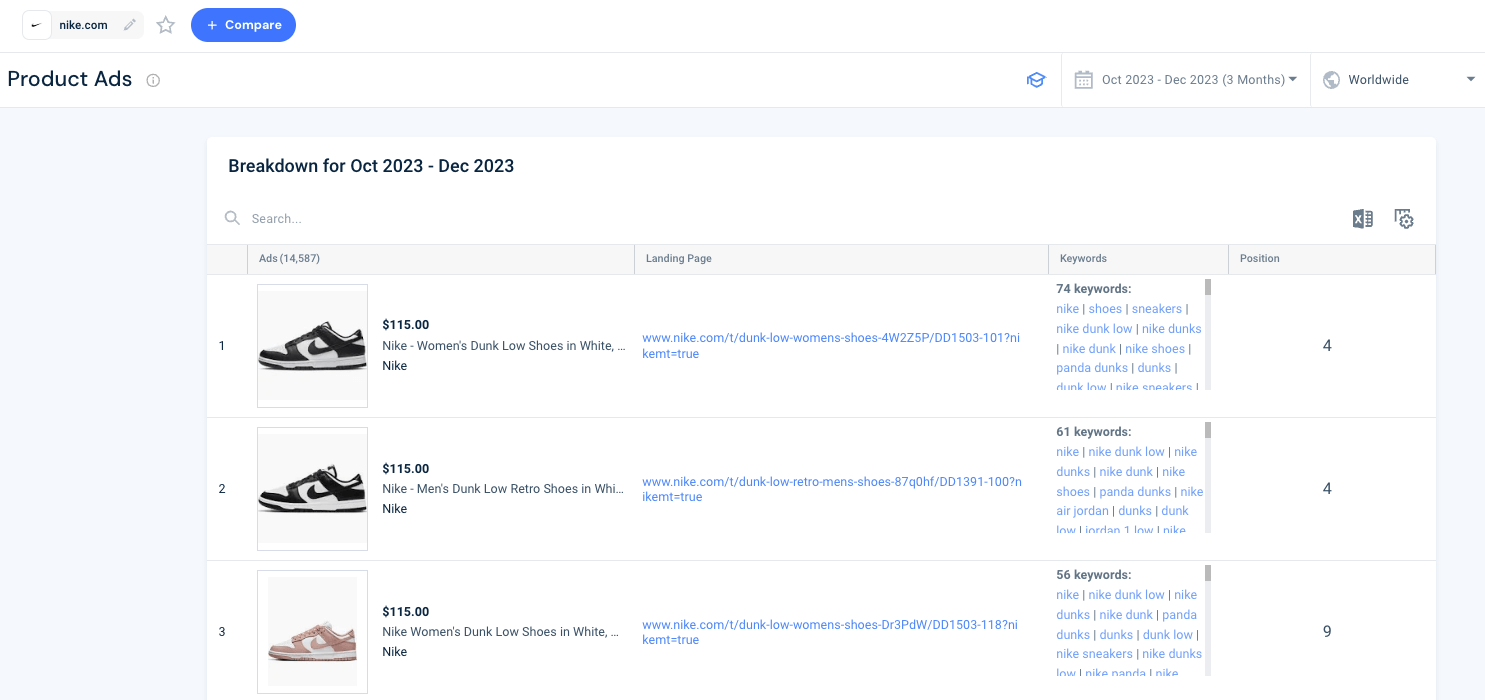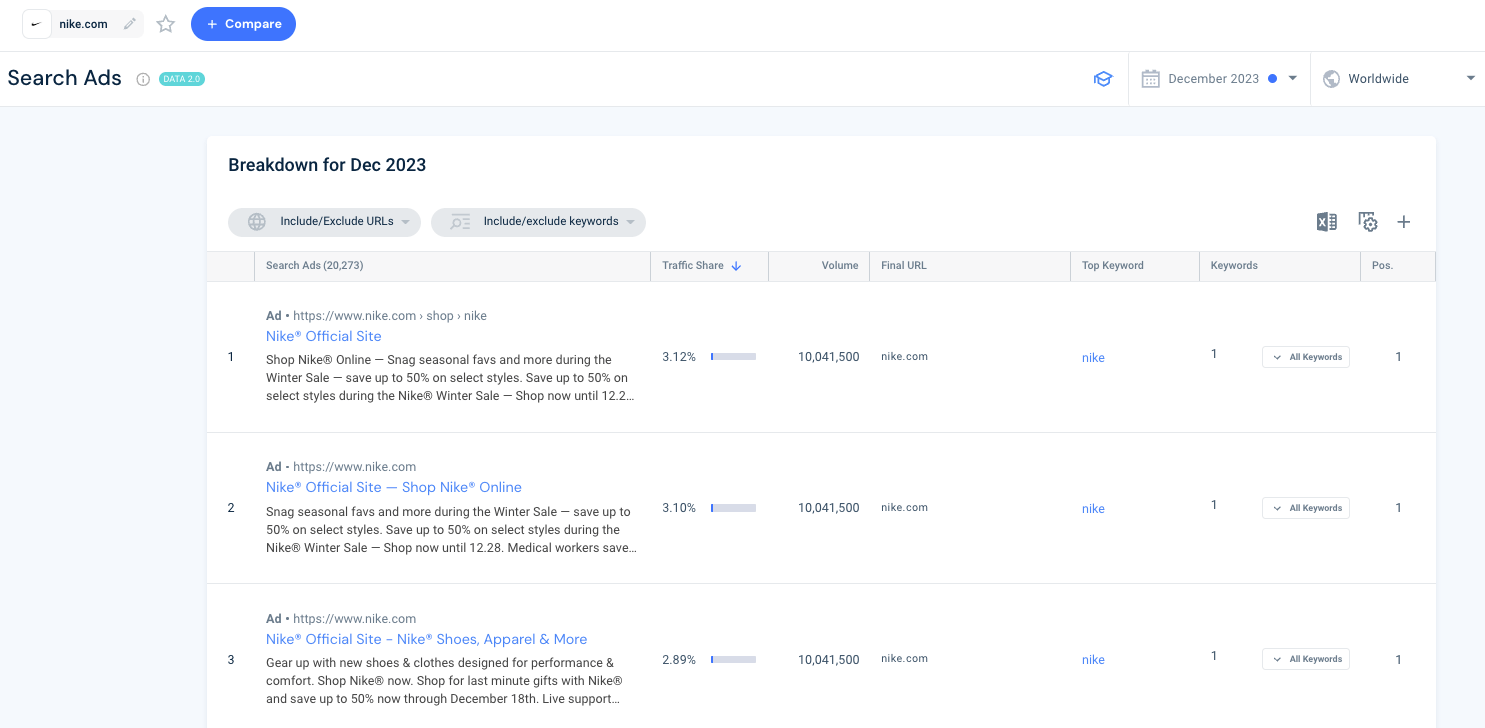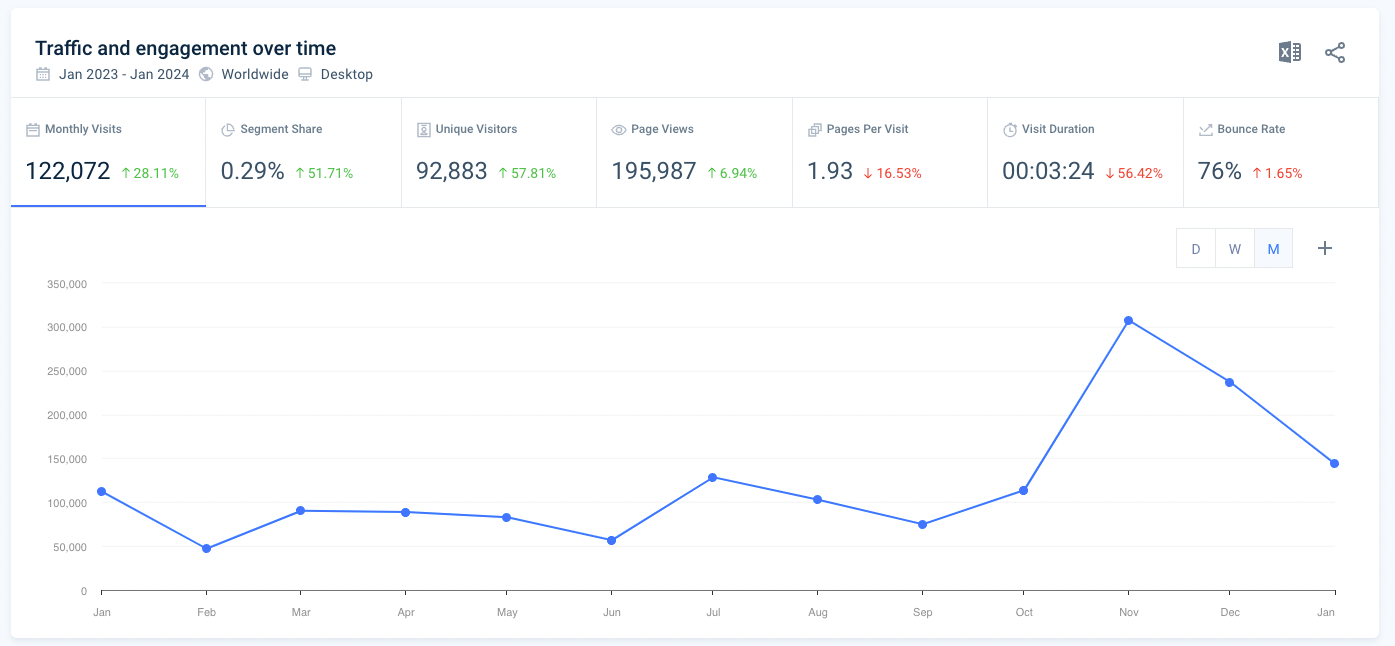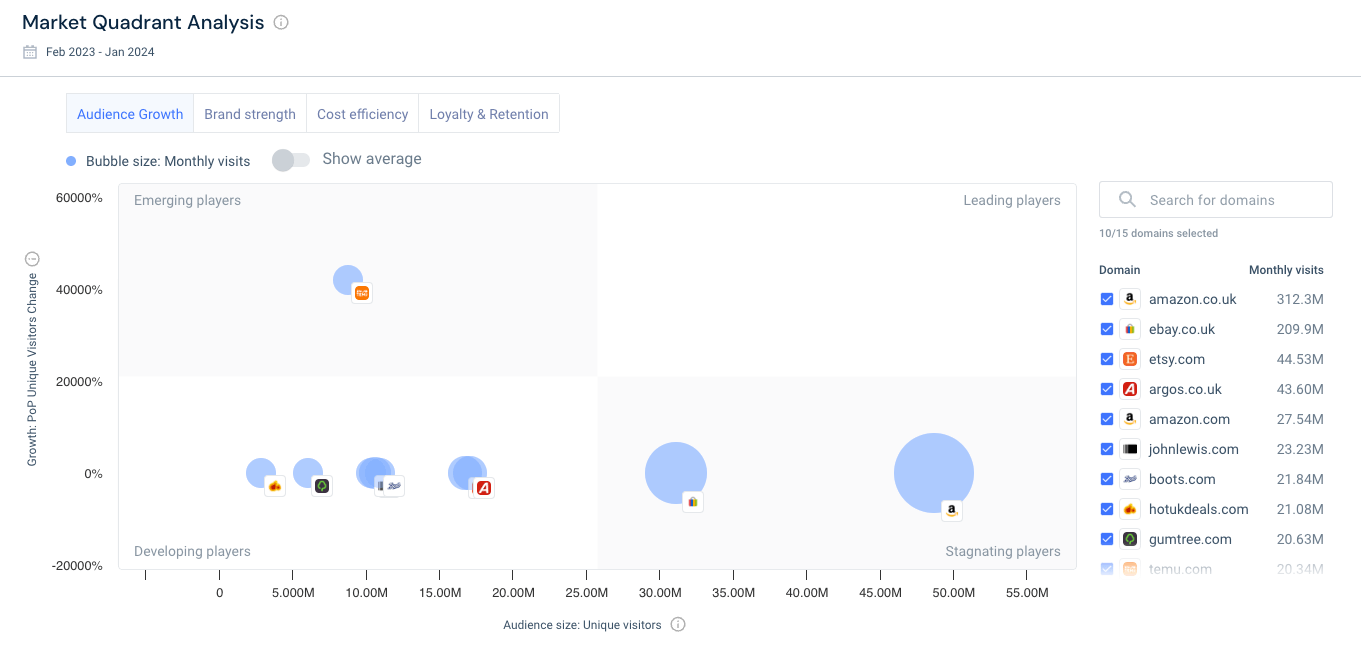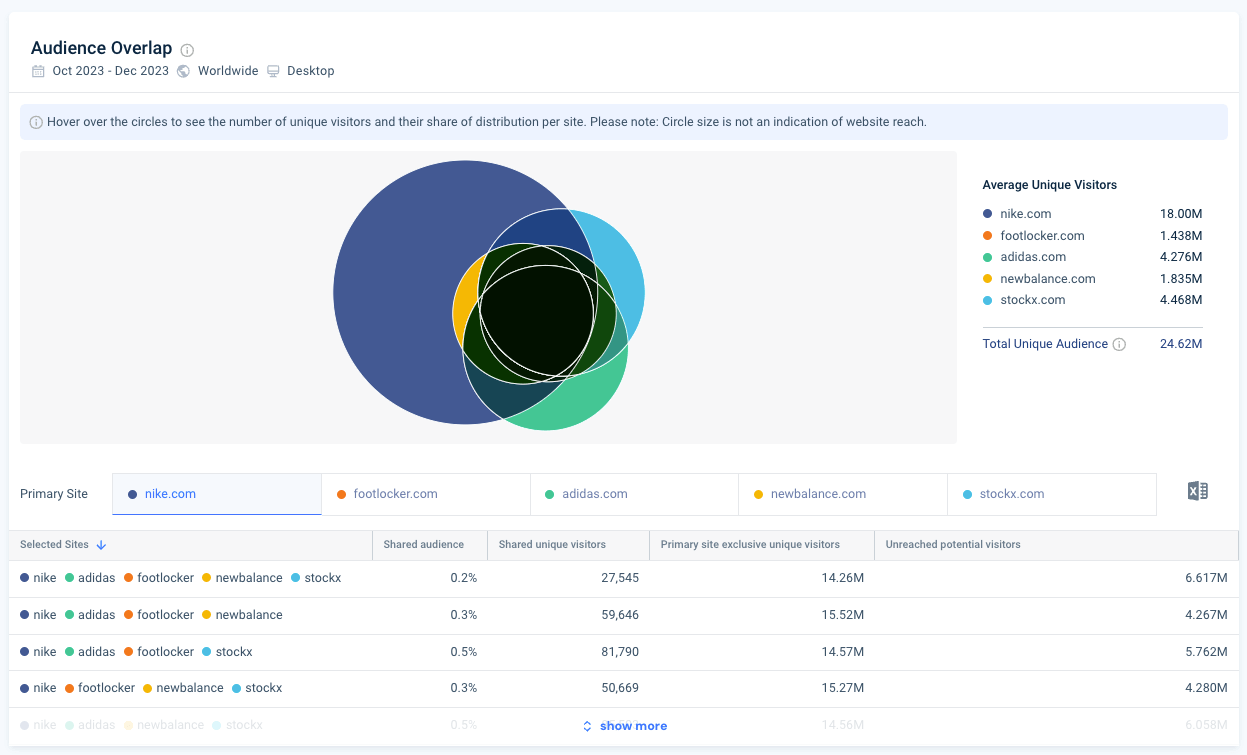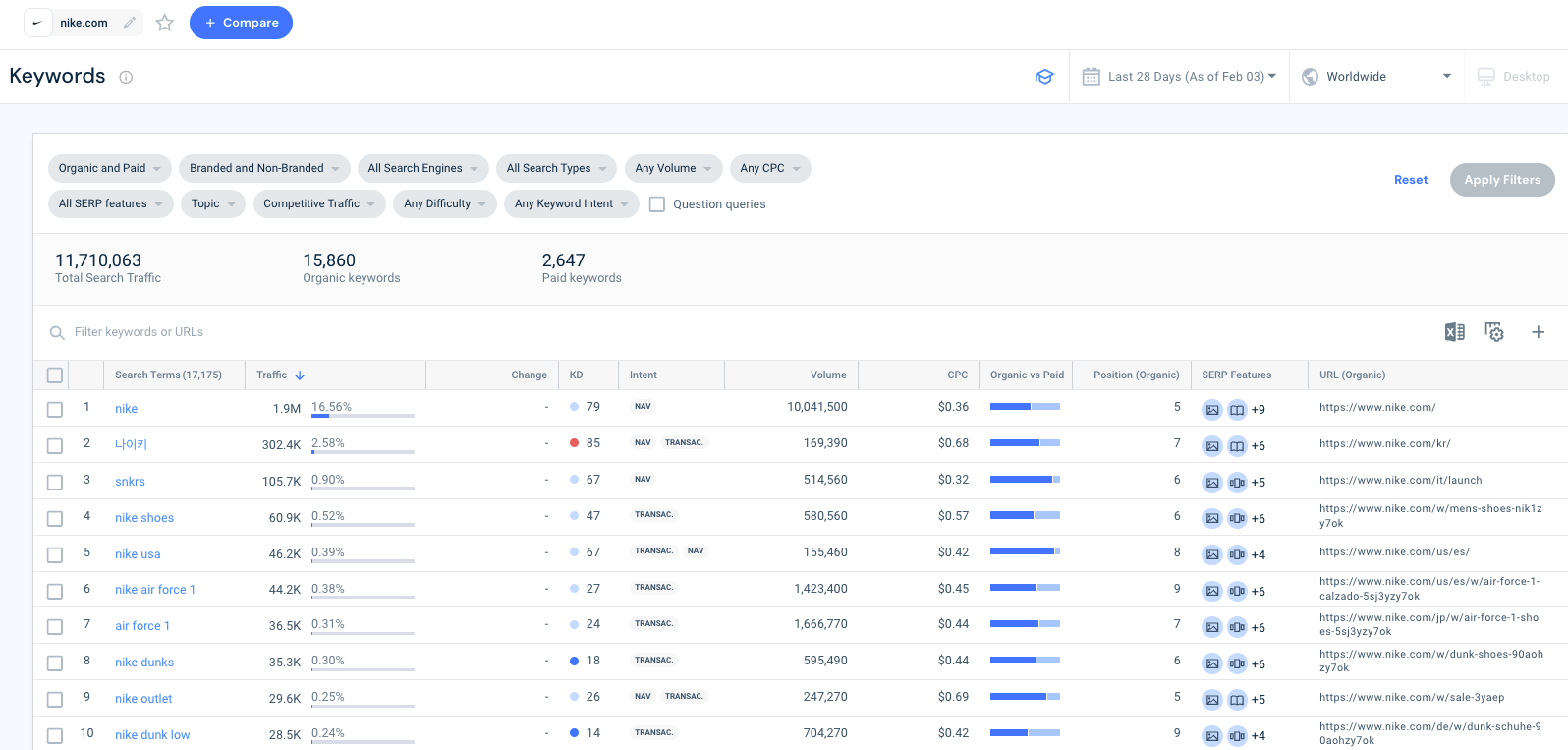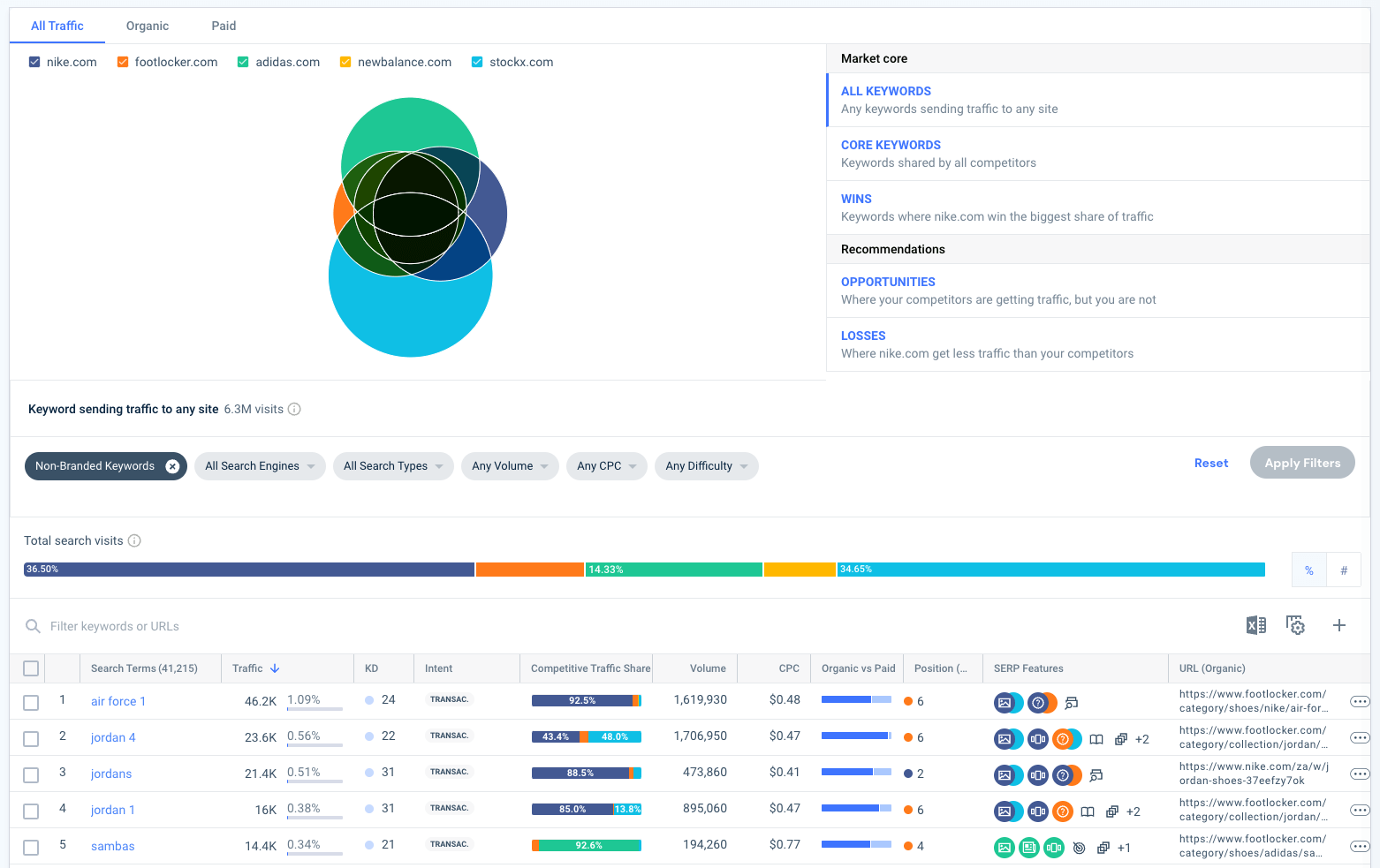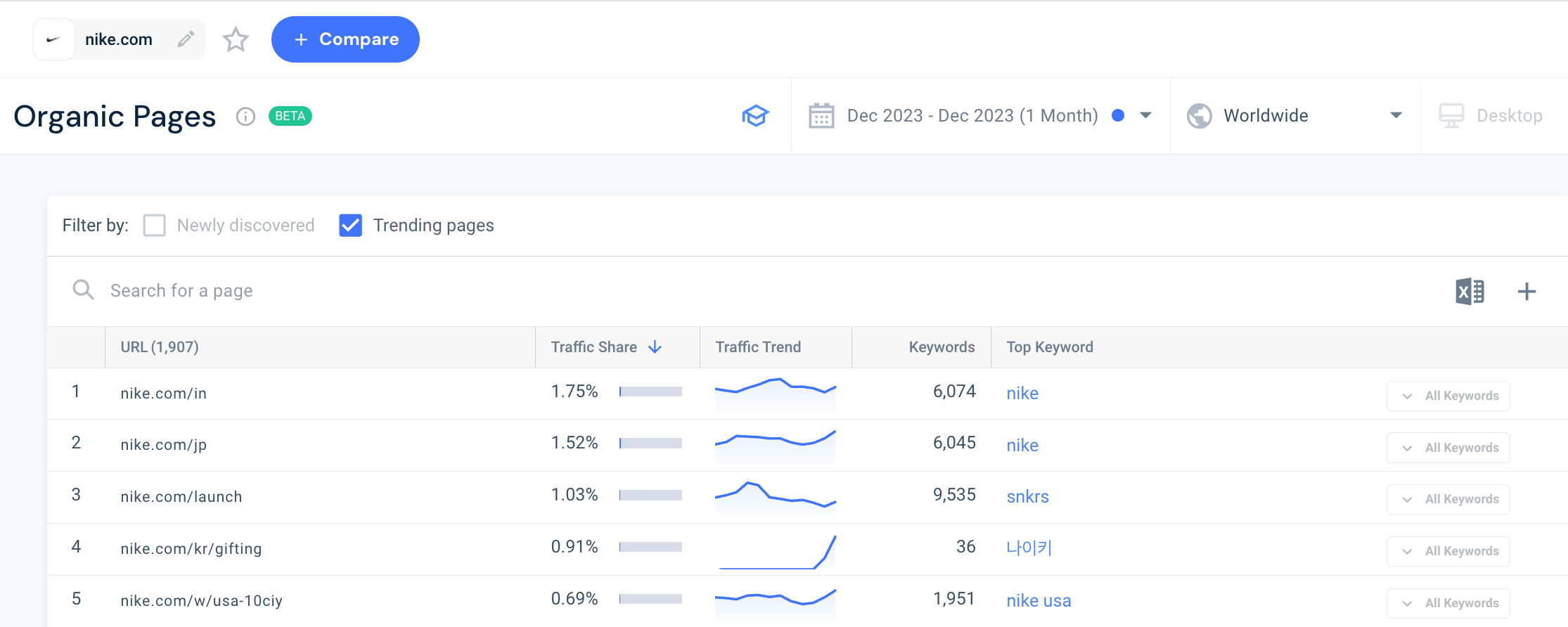How to Do an Ecommerce Competitor Analysis in 2024

Good news: Ecommerce is a booming industry.
Bad news: …that also means it’s more competitive than ever.
To be fully prepared to compete and succeed as a business, you need to know what you’re competing against – and this is exactly where ecommerce competitor analysis comes in.
Stay tuned to find out everything you need to know about competitive analysis for ecommerce, including how to run one effectively.
What is ecommerce competitor analysis?
Competitor analysis for ecommerce is discovering who your competitors are in this field, along with their strengths and weaknesses as a business. As an online industry, this type of competitor analysis relies entirely on digital signals and data.
Why is doing ecommerce competitor analysis important?
If you don’t know the ins and outs of your competitive landscape, who you’re up against, and what they’re doing with their product and marketing, it’s unlikely that you’re positioning your business in the best (and most competitive) way possible.
By taking a deep dive into relevant ecommerce competitors via thorough competitor analysis, you can:
- Identify online market trends
- Benchmark your performance
- Discover business opportunities
- Reveal your strengths and weaknesses
- Optimize your complete marketing strategy
How to do competitive analysis for ecommerce
Given the benefits, we have a feeling you might want to know how to get started. Here’s how to perform an ecommerce competitive analysis in 5 steps:
1) Define your goals
As an ecommerce business, what are your goals right now?
The first steps of any competitive analysis is to define your business goals, whether that start with:
- Expanding into new markets
- Growing your market share in existing markets
- Improving your search rankings
- Seeing more ROI from your PPC ads
- Enhancing customer engagement
- Driving more conversions and sales growth
… you get the idea. From here, your competitive analysis can be far more refined. You can work out your threats and opportunities within these spaces.
2) Reveal your ecommerce competitors
Next stop: discovering who you’re really up against.
The thing is, there are different types of competitors – you’ll have some direct competitors, indirect competitors, and some quite niche competitors. (This is where defining your next business target starts to come in handy, you see).
To reveal your ecommerce competitors, you can do your own manual research by trawling search results for your core keywords, stalking social media, and creating customer surveys, or you can get tools to do the hard work for you.
Let’s say you choose the second option, shall we?
☝️ Here is one example of a tool you can use: Similarweb’s Organic Competitors tool. Along with a (downloadable) list of domains below it, it gives you a graph view of key competitors for your website – or any other website – in terms of organic search.
Given that ecommerce is a competitive industry, we know it’s not all about organic traffic, so we’ve got a Paid Competitors tool too, providing you the same insights but for paid search.
But you don’t need to stop there. With the Market Intelligence add-on in the platform, you can also select your industry and use our competitive analysis tool to analyze your competitors’ market share, as well as the rising and declining players.
3) Analyze your competitors’ products
Once you’ve got an idea of your ecommerce competitors, it’s time to look into what they’ve got on offer.
Before you start listing “Well, this company does this, and this one does this”, we’re not only talking about the product or service. We want to know it all.
Product. Pricing. Selling platforms.
Seems like a lot of research, doesn’t it? Especially if you want to make sure your competitive analysis for ecommerce is real thorough.
☝️ Oh hello, would you look at that? Here’s our Product Ads tool, which tells you everything you need to know when it comes to how your competitors are marketing each of their products for the product-listed SERP feature.
Product image: tick. Price: tick. Landing page for more snooping: tick. Target keywords: tick. Rank: tick.
Head to Search Ads and you’ll find how their PPC ads look, as well as traffic share, search volume, and all the keywords it targets.
And if you want to really dive into your competitors’ products and their performance, you can get stuck into the data with Segment Analysis.
Take these findings one step further with Segment Analysis. Once you’ve identified products you want a closer look at, you can use this tool to analyze just how much traffic these product pages are getting and which marketing channels are sending the traffic that way.
Segment Analysis of Nike URLs that include ‘/dunk-womens-shoes’ to understand the performance of the brand’s top product ads.
4) Measure their brand positioning
Okay, so the next question on your mind probably revolves around how your competitors are positioning themselves to win these keywords, and traffic as a result.
Brand positioning (aka building brand strength) is the next step of this competitive analysis for ecommerce, and it considers:
- What industry or markets they’re playing in
- Which audience a brand is targeting
- Which problem the brand is solving
- What the brand does best
But how do you go about answering these questions?
Here, the Similarweb Market Quadrant Analysis tool looks into the strengths of chosen domains within an industry, placing them as Emerging, Developing, Leading, or Stagnating Players.
Who is this brand targeting?
To get a good understanding of a brand’s target audience, you can start with a little stalk of the main website, brand social media accounts, and online reviews to see who’s engaging in this way and what you can find out about them.
The problem is, you might not be able to find out much through these platforms, other than perhaps the fact David from Tennessee thought his new hiking socks were really excellent but only gave 4.5 stars because the color didn’t look the same as on the website.
While it’s great to hear that David’s hiking trip was not held up by low quality socks, you kinda just want to click your fingers and have demographic data right in front of you, don’t you?
Similarweb has got what you need, with insights into website demographics (like above) and audience interests, and even an audience overlap tool so you can compare audiences between up to 5 brands.
What keywords is the brand targeting?
By looking into the keywords your competitors are ranking for or bidding for, and the keywords your target audience are typing in to land on your competitors’ websites, you get a good idea of a business’ focus areas and strengths.
After all, you can’t be competitive if you don’t know what you’re competing against.
Thorough keyword research is essential to improving your visibility and performance on search, but it’s also essential within competitor analysis… to further improve your visibility and performance on search.
Using tools like our Keyword Generator ensures you’re ticking all the right boxes when it comes to your own keyword or SEO strategy, but our Rank Tracker and Keyword Analysis tools let you snoop on which keywords your competitors are doing well from.
Play around with the filters, like narrowing it down to paid or organic keywords, branded or non-branded, or picking any date range you want to know more about – including the last 28 days.
Want to see how their target keyword list compares against your business? Make the most of our Keyword Gap tool to spot the keywords you’re competing on, the keywords you’re missing out on, and the keywords you could get some quick wins on.
5) Reveal their marketing strategy
Now, if you got stuck in with the last step, you’re already one step ahead for this one.
Your research into brand positioning has given you insight into what your competitors are all about, including a look into their keyword strategies.
But if you’ve got the tools available, why stop there?
With Similarweb, you can use the analysis features and fresh data to take a deep dive into complete marketing strategies as a whole, including:
- Content marketing strategy
- SEO strategy
- PPC strategy
- Social media strategy
- Affiliate strategies
- And more…
Let’s take content marketing strategy as an example. On top of the keyword analysis tools, the Similarweb Organic Pages feature shows you the best-performing pages that any of your competitors have on organic search.
This will not only help you keep an eye on new campaigns that your competitors are running, but also give you inspiration into what your website should have to get the same customer engagement.
Paid marketers, we’re not leaving you out. You can get all the juicy details of your ecommerce competitors’ paid activities too.
On top of a full overview page of your competitors’ paid activities and PPC spends, your ecommerce competitive analysis can dig deeper into those activities using our other features, including:
- Paid Landing Page Analyzer: Top-performing pages via paid search
- Search Ads Analytics: Monthly paid ad content, traffic share and volume
- Product Ads Analytics: Content optimized for SERP features, inc. price and image
With insight into your ecommerce competitors’ paid ads and activities, you can pinpoint their strengths and weaknesses to work out your own threats and opportunities in this realm.
Don’t let your competitors have all the fun
Do your ecommerce competitor analysis, optimize your marketing strategy, stand out in a competitive industry, and outperform all your key competitors. It’s as easy as that.
If you’re keen to skip the manual research and want an all-in-one marketing platform to do the hard work for you, Similarweb might just be the one for you.
But don’t just take our word for it – try the platform for free today.
FAQs
Why is competitor analysis important for an ecommerce business?
Competitor analysis is crucial for an ecommerce business as it helps identify market trends, understand competitor strategies, uncover potential opportunities, and mitigate threats. By analyzing competitors, businesses can make informed decisions to improve their own strategies and stay ahead in the competitive landscape.
What are the key components of a comprehensive competitor analysis?
A comprehensive competitor analysis typically includes evaluating competitor websites, products, pricing strategies, marketing tactics, customer reviews, and social media presence. Additionally, it may involve analyzing their strengths, weaknesses, opportunities, and threats (SWOT analysis) to gain deeper insights into their positioning in the market.
How often should I conduct competitor analysis for my ecommerce business?
The frequency of conducting competitor analysis depends on various factors such as industry dynamics, market changes, and the pace of competitors’ activities. However, it’s advisable to conduct competitor analysis at least quarterly or whenever there are significant changes in the market or competitive landscape.
What tools can I use to conduct competitor analysis effectively?
There are several tools available for conducting competitor analysis, ranging from free options like Google Alerts, to paid tools like Similarweb (though there are also free things you can do with Similarweb). These tools can help you track competitors’ online activities, keywords, backlinks, and more to gain valuable insights.
How can I leverage the insights from competitor analysis to improve my ecommerce business?
Once you’ve gathered insights from competitor analysis, you can use them to refine your own strategies. For example, you can identify gaps in the market and develop unique selling propositions (USPs) to differentiate your products or services. You can also optimize your pricing, marketing campaigns, and customer experience based on what works well for your competitors or what they might be missing.
Your full marketing toolkit for a winning strategy
The ultimate solution to help you build the best digital strategy
